Paget's disease of the breast
Overview
Paget's (PAJ-its) disease of the breast is a rare form of breast cancer. Paget's disease of the breast starts on the nipple and extends to the dark circle of skin (areola) around the nipple. Paget's disease of the breast isn't related to Paget's disease of the bone, a metabolic bone disease.
Paget's disease of the breast occurs most often after age 50. Most people with this diagnosis also have underlying ductal breast cancer, either in situ — meaning in its original place — or, less commonly, invasive breast cancer. Only rarely is Paget's disease of the breast confined to the nipple itself.
Symptoms
Paget's disease of the breast affects your nipple and usually the skin (areola) surrounding it. It's easy to mistake the signs and symptoms of Paget's disease of the breast for skin irritation (dermatitis) or another noncancerous (benign) skin condition.
Possible signs and symptoms of Paget's disease of the breast include:
- Flaky or scaly skin on your nipple
- Crusty, oozing or hardened skin resembling eczema on the nipple, areola or both
- Itching
- Redness
- A tingling or burning sensation
- Straw-colored or bloody nipple discharge
- A flattened or turned-in (inverted) nipple
- A lump in the breast
- Thickening skin on the breast
Signs and symptoms usually occur in one breast only. The disease typically starts in the nipple and may spread to the areola and other areas of the breast.
The skin changes may come and go early on or respond to topical treatment, making it appear as if your skin is healing. On average, signs and symptoms occur for several months before a diagnosis is made.
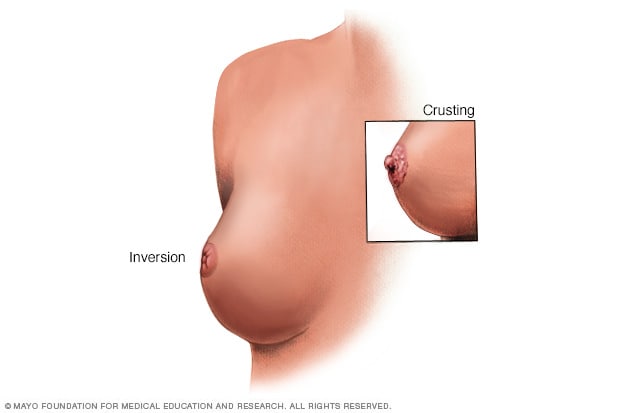
When to see a doctor
Be aware of any changes in your breasts. If you feel a lump in your breast, or if you experience itching or skin irritation that persists for more than a month, make an appointment with your doctor.
If you're being treated for a skin injury on your breast and the condition doesn't go away with treatment, make a follow-up appointment with your doctor.
Causes
Doctors don't know what causes Paget's disease of the breast. The most widely accepted theory is that the disease results from an underlying ductal breast cancer. The cancer cells from the original tumor then travel through milk ducts to the nipple and its surrounding skin. Another theory is that the disease can develop independently in the nipple.
Risk factors
Risk factors that affect your likelihood of developing Paget's disease of the breast are the same factors that affect your risk of developing any other type of breast cancer.
Some factors that make you more susceptible to breast cancer include:
- Increasing age. Your risk of breast cancer increases as you age.
- A personal history of breast conditions. If you've had a breast biopsy that found lobular carcinoma in situ (LCIS) or atypical hyperplasia of the breast, you have an increased risk of breast cancer.
- A personal history of breast cancer. If you've had breast cancer in one breast, you have an increased risk of developing cancer in the other breast.
- A family history of breast cancer. If your parent, sibling or child was diagnosed with breast cancer, particularly at a young age, your risk of breast cancer is increased. Still, the majority of people diagnosed with breast cancer have no family history of the disease.
- Inherited genes that increase cancer risk. Certain gene mutations that increase the risk of breast cancer can be passed from parents to children. The most well-known gene mutations are referred to as BRCA1 and BRCA2. These genes can greatly increase your risk of breast cancer and other cancers, but they don't make cancer inevitable.
- Radiation exposure. If you received radiation treatments to your chest as a child or young adult, your risk of breast cancer is increased.
- Obesity. Being obese increases your risk of breast cancer.
- Beginning your period at a younger age. Beginning your period before age 12 increases your risk of breast cancer.
- Beginning menopause at an older age. If you began menopause at an older age, you're more likely to develop breast cancer.
- Having your first child at an older age. If you give birth to your first child after age 30, you may have an increased risk of breast cancer.
- Having never been pregnant. If you've never been pregnant, your risk of breast cancer may be increased.
- Postmenopausal hormone therapy. Hormone therapy medications that combine estrogen and progesterone to treat the signs and symptoms of menopause may increase the risk of breast cancer. The risk decreases when you stop taking these medications.
- Drinking alcohol. Drinking alcohol increases the risk of breast cancer.
Prevention
Breast cancer risk reduction for people with an average risk
Making changes in your daily life may help reduce your risk of breast cancer. Try to:
-
Ask your doctor about breast cancer screening. Discuss with your doctor when to begin breast cancer screening exams and tests, such as clinical breast exams and mammograms.
Talk to your doctor about the benefits and risks of screening. Together, you can decide what breast cancer screening strategies are right for you.
-
Become familiar with your breasts through breast self-exam for breast awareness. You may choose to become familiar with your breasts by occasionally inspecting your breasts during a breast self-exam for breast awareness. If there is a new change, lumps or other unusual signs in your breast, talk to your doctor promptly.
Breast awareness can't prevent breast cancer, but it may help you to better understand the normal changes that your breasts undergo and identify any unusual signs and symptoms.
- Drink alcohol in moderation, if at all. If you choose to drink alcohol, do so in moderation. For healthy adults, that means up to one drink a day for women and up to two drinks a day for men.
- Exercise most days of the week. Aim for at least 30 minutes of exercise on most days of the week. If you haven't been active lately, ask your doctor whether it's OK and start slowly.
-
Limit postmenopausal hormone therapy. Combination hormone therapy may increase the risk of breast cancer. Talk with your doctor about the benefits and risks of hormone therapy.
You may experience bothersome signs and symptoms during menopause and, for you, the increased risk of breast cancer may be acceptable in order to relieve menopause signs and symptoms.
To reduce the risk of breast cancer, use the lowest dose of hormone therapy possible for the shortest amount of time.
- Maintain a healthy weight. If your weight is healthy, work to maintain that weight. If you need to lose weight, ask your doctor about healthy strategies to accomplish this. Reduce the number of calories you eat each day and slowly increase the amount of exercise.
- Choose a healthy diet. Eating a Mediterranean diet supplemented with extra-virgin olive oil and mixed nuts may reduce your risk of breast cancer. The Mediterranean diet focuses mostly on plant-based foods, such as fruits and vegetables, whole grains, legumes, and nuts. People who follow the Mediterranean diet choose healthy fats, such as olive oil, over butter and fish instead of red meat.
Breast cancer risk reduction for people with a high risk
If your doctor has determined that you have an increased risk of breast cancer, you may discuss options to reduce your risk, such as:
-
Preventive medications (chemoprevention). Estrogen-blocking medications reduce the risk of breast cancer if you have a high risk of the disease.
These medications carry a risk of side effects, so doctors reserve these medications for those who have a very high risk of breast cancer. Discuss the benefits and risks with your doctor.
- Preventive surgery. If you have a very high risk of breast cancer, you may choose to have your healthy breasts surgically removed (prophylactic mastectomy). You may also choose to have your healthy ovaries removed (prophylactic oophorectomy) to reduce the risk of both breast cancer and ovarian cancer.
Diagnosis
Tests and procedures used to diagnose Paget's disease of the breast include:
- Breast exam. Your doctor will check both of your breasts and the lymph nodes in your armpit, feeling for any lumps or other abnormalities.
- Mammogram. A mammogram is an X-ray of the breast. Mammograms are commonly used to screen for breast cancer. If an abnormality is detected on a screening mammogram, your doctor may recommend a diagnostic mammogram to further evaluate that abnormality.
- Breast ultrasound. Ultrasound uses sound waves to produce images of structures deep within the body. Ultrasound may be used to determine whether a new breast lump is a solid mass or a fluid-filled cyst.
- Breast magnetic resonance imaging (MRI). An MRI machine uses a magnet and radio waves to create pictures of the interior of your breast. Before a breast MRI, you receive an injection of dye.
- Removing a sample of breast cells for testing (biopsy). During a biopsy, your doctor removes a sample of suspicious tissue. Biopsy samples are sent to a laboratory for analysis to determine whether the cells are cancerous. A biopsy sample is also analyzed to determine the type of cells involved in the breast cancer, the aggressiveness (grade) of the cancer, and whether the cancer cells have hormone receptors or other receptors that may influence your treatment options.
Other tests and procedures may be used depending on your situation.
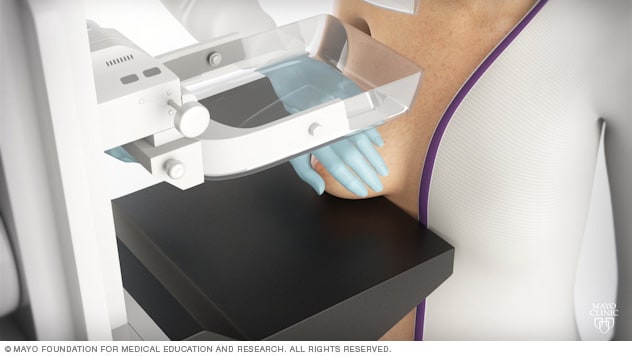
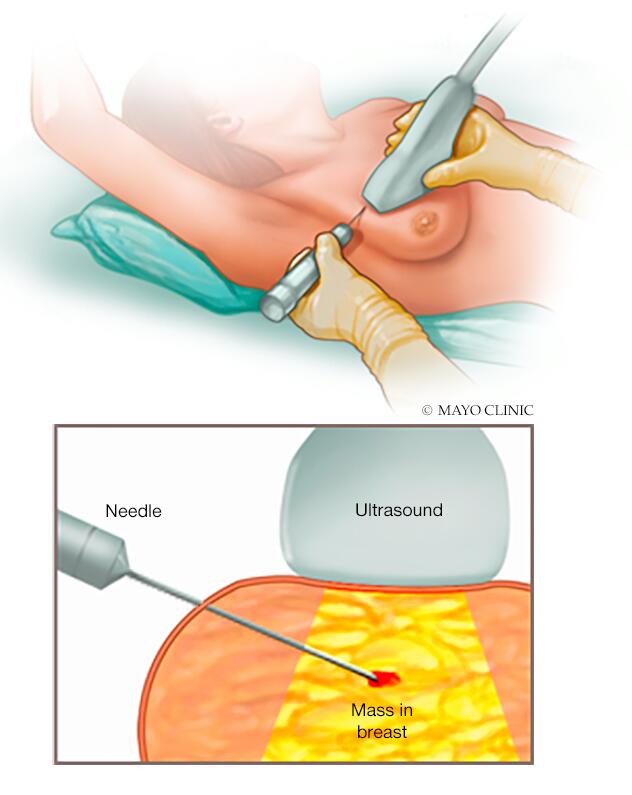
Treatment
If you have Paget's disease of the breast, you will likely need surgery. The type of surgery depends on the condition of the skin around your nipple and how advanced the underlying cancer is.
Surgical options include:
- Removing the entire breast (mastectomy). A mastectomy is an operation to remove all of your breast tissue. Most mastectomy procedures remove all of the breast tissue — the lobules, ducts, fatty tissue and some skin, including the nipple and areola (total or simple mastectomy).
- Removing the breast cancer (lumpectomy). During a lumpectomy, which may be referred to as breast-conserving surgery or wide local excision, the surgeon removes the cancer and a small margin of surrounding healthy tissue. If you and your doctor choose this option, you will also receive radiation therapy afterward.
-
Removing a limited number of lymph nodes (sentinel node biopsy). To determine whether cancer has spread to your lymph nodes, your surgeon will discuss with you the role of removing the lymph nodes that are the first to receive the lymph drainage from your cancer.
If no cancer is found in those lymph nodes, the chance of finding cancer in any of the remaining lymph nodes is small and no other nodes need to be removed.
- Removing several lymph nodes (axillary lymph node dissection). If cancer is found in the sentinel lymph nodes, your surgeon will discuss with you the role of removing additional lymph nodes in your armpit.
- Removing both breasts. Some people with cancer in one breast may choose to have their other (healthy) breast removed (contralateral prophylactic mastectomy) if they have a very increased risk of cancer in the other breast because of a genetic predisposition or strong family history.
You may choose to have breast reconstruction after surgery. Discuss your options and preferences with your surgeon.
Consider a referral to a plastic surgeon before your surgery. Your options may include reconstruction with a breast implant or reconstruction using your own tissue. These operations can be performed at the time of your mastectomy or at a later date.
Adjuvant therapy
After your operation, your doctor may recommend additional treatment (adjuvant therapy) with anti-cancer drugs (chemotherapy), radiation therapy or hormone therapy to prevent a recurrence of breast cancer.
Your specific treatment will depend on the extent of the cancer and whether your cancer tests positive for certain characteristics, such as having estrogen or progesterone receptors.
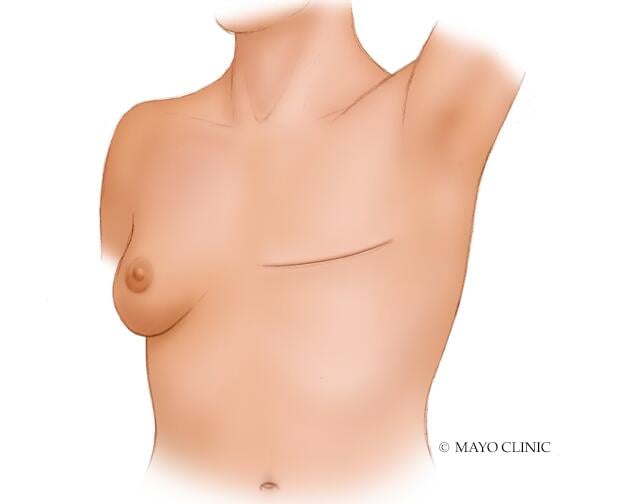
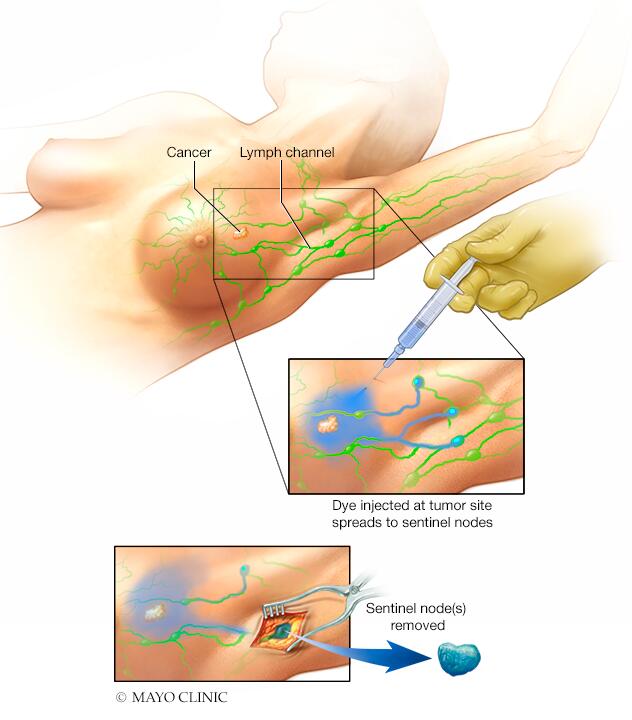
Coping and support
A breast cancer diagnosis can be overwhelming. And just when you're trying to cope with the shock and the fears about your future, you're asked to make important decisions about your treatment.
Everyone finds a personal way of coping with a cancer diagnosis. Until you find what works for you, it might help to:
-
Learn what you need to know about your breast cancer. If you'd like to know more about your breast cancer, ask your doctor for details — the type, stage and hormone receptor status. Ask for good sources of up-to-date information on your treatment options.
Knowing more about your cancer and your options may help you feel more confident when making treatment decisions. Still, some people may not want to know the details of their cancer. If this is how you feel, let your doctor know that, too.
-
Talk with other breast cancer survivors. You may find it helpful and encouraging to talk to other people with breast cancer. Contact the American Cancer Society to find out about support groups in your area.
Organizations that can connect you with other cancer survivors online or by phone include After Breast Cancer Diagnosis and CancerCare.
- Find someone to talk with. Find a friend or family member who is a good listener or talk with a clergy member or counselor. Ask your doctor for a referral to a counselor or other professional who works with cancer survivors.
-
Keep your friends and family close. Your friends and family can provide a crucial support network for you during your cancer treatment.
As you begin telling people about your breast cancer diagnosis, you'll likely get many offers for help. Think ahead about things you may want help with, whether it's having someone to talk to if you're feeling low or getting help preparing meals.
- Take care of yourself. Make your well-being a priority during cancer treatment. Get enough sleep so that you wake feeling rested, choose a diet full of fruits and vegetables, make time for gentle exercise on days you feel up to it, and find time for things you enjoy, such as reading or listening to music.
Preparing for your appointment
If you suspect that you have Paget's disease of the breast, your initial appointment might be with your family doctor. Or, when you call for an appointment, you may be referred directly to a doctor who specializes in treating breast conditions.
What you can do
To prepare for your appointment:
- Be aware of any pre-appointment restrictions. At the time you make the appointment, be sure to ask if there's anything you need to do in advance, such as restrict your diet.
- Write down any symptoms you're experiencing. Include even those that may seem unrelated to the reason for which you scheduled the appointment.
- Write down key personal information. Include any major stresses or recent life changes.
- Make a list of all medications. Also include vitamins or supplements that you're taking.
- Consider taking a family member or friend along. Sometimes it can be difficult to remember all the information provided during an appointment. Someone who accompanies you may remember something that you missed or forgot.
- Write down questions to ask your doctor.
Your time with your doctor is limited, so preparing a list of questions can help you make the most of your time together. Some basic questions to ask include:
- What is likely causing my symptoms or condition?
- What are other possible causes for my symptoms or condition?
- What kinds of tests do I need?
- Is my condition likely temporary or chronic?
- What is the best course of action?
- What are the alternatives to the primary approach that you're suggesting?
- I have other health conditions. How can I best manage them together?
- Are there any restrictions that I need to follow?
- Should I see a specialist? What will that cost, and will my insurance cover it?
- Are there brochures or other printed materials that I can take with me? What websites do you recommend?
- What will determine whether I should plan for a follow-up visit?
What to expect from your doctor
Your doctor may ask you questions about:
- The nature of the skin changes on your nipple
- Whether you also experience nipple discharge, bleeding, burning or itching
- Whether you have any other breast signs and symptoms, such as a breast lump or area of thickening
- Whether you have any breast pain
- How long you've experienced signs and symptoms
Your doctor may also ask questions about your personal and family medical history and other possible risk factors for breast cancer.
Last Updated May 20, 2021
© 2024 Mayo Foundation for Medical Education and Research (MFMER). All rights reserved. Terms of Use



